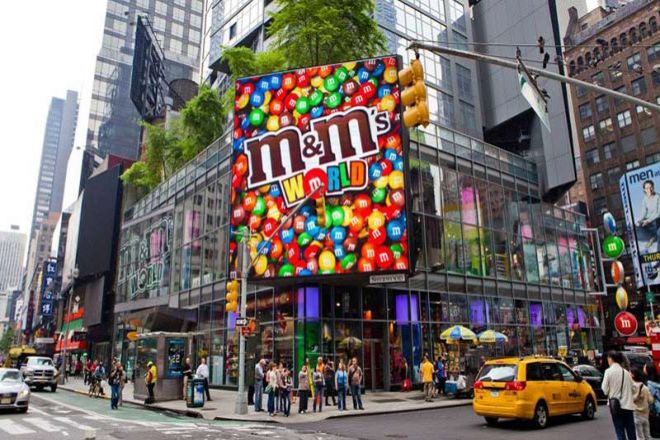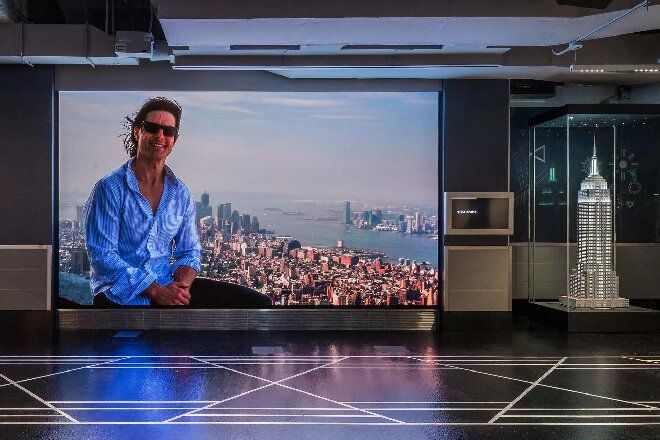序章

いつ digital signage in a bustling commercial district is no longer a static picture or text but a “live” billboard with brilliant colors and vivid pictures, how will you be attracted? This is the new life that LED technology gives to digital signage.
In the digital age, how can we more effectively capture the public’s attention? How can we convey information in a more intuitive and shocking way? LED technology, with its unique brightness, color and flexibility, is quietly changing the landscape of digital signage. It is not only a technological advancement, but also a revolution in the way of commercial display and information dissemination.
1. Basics of LED technology, simply put

LED, the full name of which is a light-emitting diode sounds high-tech, but in fact, it is like a small electronic light bulb. However, this “light bulb” is amazing. It can directly turn electricity into light without heating and then emitting light like traditional light bulbs.
Its working principle is actually very simple. For example, there are two rooms in the LED; one is full of “electrons” (we call them N-type semiconductors), and the other is full of “empty positions” (we call them P-type semiconductors).
When the current comes, the electrons can’t wait to run from the N-type room to the P-type room to find an empty space, just like children looking for empty seats to play in an amusement park. When they meet, they release energy, and this energy becomes the light we see.
The characteristics of LED technology are mainly reflected in the following aspects:
1). High efficiency and energy-saving
- 低い エネルギー消費:
LED technology can efficiently convert electrical energy into light energy. Compared with traditional lighting technologies (such as incandescent lamps and fluorescent lamps), LED consumes less energy at the same brightness. This efficient conversion characteristic gives LED technology a significant advantage in energy saving and emission reduction.
- 長さ 人生:
The service life of LED can usually reach more than tens of thousands of hours, far exceeding traditional lighting products. This means that LED products need to be replaced less frequently during use, further reducing energy consumption and maintenance costs.
2). Environmental protection and health
- No harmful substances:
LED products do not contain harmful substances such as mercury, so they do not pollute the environment during production, use, and disposal, which is in line with the concept of green lighting.
- No ultraviolet and infrared radiation:
LED does not generate ultraviolet and infrared radiation during light emission, which is harmless to human health and suitable for various places that require long-term lighting.
3). Fast response and rich colors
- Fast response:
LED has an extremely short response time, ranging from a few milliseconds to tens of milliseconds, which makes LED perform well in applications that require fast switching of brightness and color, such as display screens, traffic lights, etc.
- 豊かな色彩:
LED technology can emit light in multiple colors such as red, yellow, blue, and green, and full-color display can be achieved by mixing different colors of LED. This rich color feature gives LED broad application prospects in advertising, decoration, stage lighting, and other fields.
4). Fourth, small size and lightweight
- Easy to integrate:
LED chips are small in size and light in weight, which makes them easy to integrate with other electronic components to form various powerful LED devices and modules. This feature makes LED technology widely used in electronic products, automotive electronics, aerospace, and other fields.
2. LED technology makes digital signage brighter and more dazzling
The introduction of LED technology has greatly enhanced the expressiveness and attractiveness of digital signage, making it stand out among many information dissemination media and become brighter and more dazzling. Specifically, the improvement of digital signage by LED technology is reflected in the following aspects:
- Enhanced brightness and clarity
LED technology provides excellent display effects for digital signage with its high brightness characteristics. Even in brightly lit environments, such as outdoor billboards or inside large shopping malls, LED digital signage ensures that content is clearly visible.
At the same time, as the pixel density of LEDs increases, the clarity of digital signage has also been significantly improved, making images and text more delicate and realistic.
- Rich color rendering
LED technology can emit light in a variety of colors and achieve full-color display through precise color control. This rich color rendering capability enables digital signage to present more vivid and gorgeous pictures when displaying content.
Whether it is a static picture or a dynamic video, LED digital signage can attract the audience’s attention with more vivid colors and delicate color transitions and enhance the attractiveness of information.
- Enhanced dynamics and interactivity
LED technology makes digital signage no longer limited to static display, but can realize various dynamic effects and interactive functions through programming control.
For example, digital signage can automatically adjust the display content according to the time, weather, or changes in the behavior of the audience to achieve personalized push.
In addition, touch screen technology can also be integrated to allow the audience to interact with the digital signage by touching the screen, enhancing the sense of participation and experience.
3. LED technology makes digital signage more fun

LED technology makes digital signage more fun, mainly in the following aspects, bringing new interactive experiences and entertainment enjoyment to the audience:
- Enhanced interactivity
LED digital signage is no longer just a one-way transmitter of information but can become a medium for interaction with the audience.
By integrating technologies such as touch screens, sensors, or mobile phone apps, the audience can interact with digital signage by touching the screen, waving, scanning QR codes, etc.
This instant feedback and interaction makes information acquisition more interesting and proactive and enhances the audience’s sense of participation and immersion.
- Dynamic changes and personalized customization
The flexibility and programmability of LED technology enable digital signage to display rich and diverse dynamic content. Whether it is dynamic images, videos, animations, or real-time data, they can be customized and updated in real time as needed.
This dynamic change not only attracts the audience’s attention but also enables digital signage to push personalized content based on the audience’s interests and behaviors, providing content that is more in line with their needs.
- Gamification and entertainment
LED digital signage can also incorporate game elements to become a new form of entertainment.
For example, in ショッピングモール また 展示会, interactive game areas based on LED technology can be set up, where viewers can participate in games by touching the screen or using body movements and experience the fun of interacting with digital signage.
This kind of gamification and entertainment design not only attracts a large number of viewers to stop and watch and participate but also enhances the activity and attractiveness of the venue.
- Creative display and visual feast
The high brightness and rich colors of LED technology provide a broad creative space for digital signage. Designers can use LED technology to create a variety of unique visual effects and display forms, such as 3D stereoscopic displays, light and shadow interaction, virtual reality, etc.
These creative displays not only make digital signage the visual focus but also bring a visual feast to the audience, improving the overall viewing experience and entertainment.
- Intelligent management and remote control
LED digital signage usually has the functions of intelligent management and remote control. Through the Internet of Things technology and cloud platform, managers can monitor the operating status, content playback, and audience interaction data of digital signage in real-time and remotely control and adjust them.
This intelligent management not only improves work efficiency and accuracy but also enables digital signage to be flexibly adjusted and optimized according to the needs of different times and places, providing more accurate and interesting content display.
4. LED digital signage greatly improves commercial value

- Improve brand image and recognition
LED digital signage, with its high brightness, high definition, and rich color expression, can create a more eye-catching and professional brand image. Whether in indoor or outdoor environments, LED digital signage can ensure the clear communication of brand information and attract customers’ attention.
This intuitive and high-quality display method helps to improve the brand’s awareness and favorability in the minds of consumers, thereby enhancing the brand’s commercial value.
- Enhance advertising effect and conversion rate.
LED digital signage supports dynamic and diverse content display, including videos, animations, real-time data, etc., which can attract more customers’ attention. Compared with static ads, dynamic ads can better catch customers’ eyes and increase the attractiveness and memorability of ads.
In addition, LED digital signage can also achieve precise delivery based on factors such as time, location, and customer interests, improve the targeting and conversion rate of advertising, and bring higher commercial value to enterprises.
- Promote customer interaction and participation.
Many LED digital signages integrate interactive technologies such as touch screens and sensors, allowing customers to interact with digital signage by touching, waving, etc. This interactive experience not only increases the fun but also improves customer participation and satisfaction.
Through interaction, companies can collect customer information and feedback, further understand customer needs and preferences, and provide data support for precision marketing. At the same time, interactive experiences can also enhance the emotional connection between customers and brands, enhance brand loyalty, and create more business value for companies.
- Optimize operating costs and efficiency.
LED technology is characterized by high efficiency and energy saving and can significantly reduce energy consumption compared to traditional lighting products. Over a long period of time, LED digital signage has obvious advantages in terms of operating costs.
In addition, LED digital signage also supports remote control and intelligent management. Companies can monitor and dispatch digital signage in real-time through cloud platforms to improve operational efficiency and management levels.
This cost-saving and efficiency improvement will help companies achieve higher profitability and market competitiveness and further enhance their business value.
- Expand market applications and business value.
With the advancement of technology and the development of the market, the application areas of LED digital signage are constantly expanding. In addition to traditional commercial advertising, information release, and other fields, LED digital signage can also be applied to スマートシティ, public transportation, cultural tourism, and other fields.
This wide range of application scenarios provides companies with more business opportunities and market space. Through continuous innovation and application, enterprises can further explore the commercial value of LED digital signage and achieve diversified development and sustainable growth.
結論
In summary, LED technology, with its unique charm and unlimited potential, is profoundly changing the face of the digital signage industry. From improving display effects to expanding application scenarios, from technological innovation to market prosperity, LED technology plays a vital role. It not only brings a more vivid and realistic visual experience to digital signage but also promotes the intelligent and personalized development of the entire industry.
最後に、LEDディスプレイスクリーンについてさらに詳しく知りたい場合は、 ご連絡ください。
